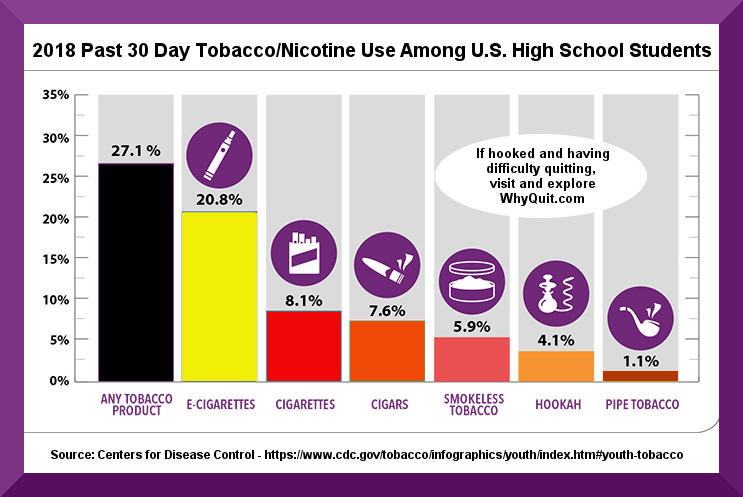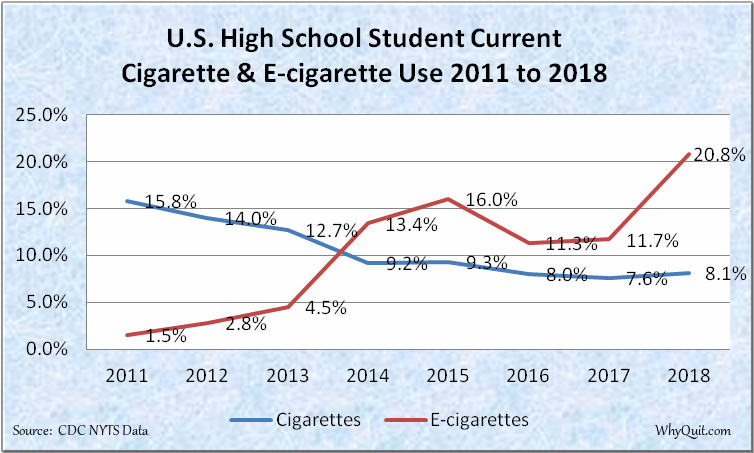
Youth Smoking, Vaping &
Nicotine Dependency Prevention
Kids and vaping: an ounce of prevention is worth a pound of cure
Vaping: What you can’t see can still hurt you
How you can help prevent kids from vaping
STUDENT ALERT: e-cigarettes & juuling are dangerous
Kids Just Don't Get It!
Parent to parent e-cigarette, Juul and nicotine addiction warnings
How to help kids stop vaping
Frightening Trends in Teenage Smoking
What Can We Do to Stop the Rise of Teen Smoking?
Why I don't speak at more sites on how to help people quit smoking

Why care about child and teen tobacco use?
Reflect on these youth nicotine use facts:
- Nearly 9 of 10 adults who ever smoked a cigarette had their first cigarette by their 18th birthday.
- Each day in the United States, about 2,000 youth under 18 years of age smoke their first cigarette, and more than 300 youth under 18 become daily cigarette smokers. Among adolescent daily smokers, roughly 1 in 3 will die prematurely from a smoking-related disease.
- While cigarette smoking had declined since 2011, by 2018 the decline had stalled, the same year we witnessed the greatest one-year adolescent nicotine-use increase ever, primarily due to the popularity of student vaping of 5% nicotine salts juice from JUUL e-cigarettes (juuling).
- During 2018, roughly 1 in 4 high school students (27.1%) reported current (in the past 30 days) nicotine/tobacco product use (e-cigarettes, cigarettes, cigars, smokeless tobacco, hookah or pipe tobacco).
- Nearly 1 of every 20 middle school students (4.9%) reported in 2018 that they used electronic cigarettes in the past 30 days, an increase from 0.6% in 2011.
- During 2018, 1 of every 5 high school students (20.8%) disclosed that they used electronic cigarettes in the past 30 days - an increase from 1.5% in 2011.
- Although only 5% of daily smokers surveyed in high school said they would definitely be smoking five years later, close to 75% were actually smoking 7 to 9 years later.
- If smoking persists at the current rate among youth in this country, 5.6 million of today's Americans younger than 18 years of age are projected to die prematurely from a smoking-related illness. This represents about one in every 13 Americans aged 17 years or younger alive today.
- Of 1,000 20-year-olds who continue to smoke, 6 will die prematurely from homicide, 12 from car accidents, and 500 from smoking.

With all that we know about the dangers of nicotine, why do so many adolescents still start using it every day? Early experimentation with a variety of nicotine containing products historically has lead to a lifelong nicotine addiction and then often to cigarettes, a delivery method that is so deadly that smoking has been deemed the most preventable cause of premature death in almost all developed nations.
Students taking up smoking or any nicotine delivery systems today are likely to spend their entire life dependent upon a product that will end up costing them tens of thousands of dollars, and very possibly their health and their lives. Again though, children and teens are still taking up nicotine usage in large numbers.
What can be done to help prevent children and teenagers from developing a lifelong addiction to nicotine? The above resources explore the reasons why so many children and adolescents take up smoking or nicotine delivery each year. They offer practical advice on what public health officials can do to help to reverse these trends. They also explain how teachers and school administrators can protect their students, as well as what parents can do to help their children avoid becoming addicted.
